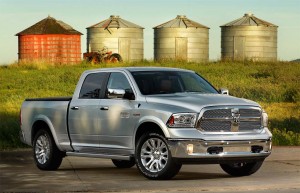
Even big trucks - like this Ram 1500 EcoDiesel are getting better mileage than ever, according to UMTRI.
With fuel prices dipping below $3.00 a gallon in many parts of the country, sales of pickup trucks, utility vehicles – even minivans – have been on the rise in recent months. Despite the resurgence of these gas-gulping vehicles, the overall mileage of the new vehicles sold in November continued to rise.
The typical vehicle sold last month delivered an EPA-rated fuel economy of 24.8 mpg in November, up 0.1 mpg from the revised October figure, according to the University of Michigan Transportation Research Institute, or UMTRI.
Perhaps more significantly, that means the typical new vehicle is now getting about 23% better mileage – a 4.7 mpg average increase, since October 2007, the first month of monitoring by UMTRI, noted lead researchers Michael Sivak and Brandon Schoettle.
The improvements in fuel economy this year have come even as the U.S. auto industry was enjoying its best year since 2007’s economic meltdown – with a resurgence of the light truck market helping drive the boom. Sales last month increased by roughly 8%, with the year expected to end with total sales of around 15.5 million – a more than 50% surge since the industry’s low point during the Great Recession.
(Click Herefor more on November’s sales surge.)
The sales surge has been driven by a steady increase in demand for products across the board, but there’s been a particularly strong revitalization of the pickup truck market – benefitting in particular General Motors, Ford Motor Co. and the Chrysler Group. In addition, sales of utility vehicles such as the Jeep Grand Cherokee and Chevrolet Traverse have been rebounding.
But today’s trucks are significantly different from those of just a decade ago. Ford, for example, now sells more V-6-power F-Series trucks than those equipped with V-8s. Chrysler launched a new, high-mileage Ram 1500 diesel for 2014 – this week winning the coveted Motor Trend Truck of the Year award in the process. Along with these new, higher-mileage powertrains, makers are also moving to cut mass. The new 2014 Range Rover Sport, for example, is about 700 pounds lighter than the model it replaces.
(Automakers introduce an assortment of new, high-mileage 3-cylinder engines. Click Here for more.)
Similar improvements have been made to U.S. passenger cars, as well, and a growing number of models are adopting alternative powertrains – such as the new 50 mpg Honda Accord Hybrid.
While hybrids, efficient diesel powered vehicles and electric vehicles are an expanding part of the American fleet, utility vehicles with conventional gasoline driven internal combustion engines so far account for approximately one third of all vehicles sold in the U.S. this year, so newer technologies, such as the Ford EcoBoost V-6 engine, can have a tremendous, positive impact on overall U.S. fuel economy.
Along with its fuel economy assessment, UMTRI issued a monthly update of its national Eco-Driving Index, which estimates the average monthly emissions generated by an individual U.S. driver. The EDI takes into account both the fuel used per mile driven and the amount of driving motorists actually clock each month.
(Ram 1500 Diesel wins Motor Trend Truck of the Year. Click Here for the story.)
For the third straight month, the EDI tied its best-ever mark at 0.80 (the lower the value, the better) during September, the sixth time that it has registered that low in the past two years. The index currently shows that emissions of greenhouse gases per driver of newly purchased vehicles have dropped 20%, overall, since October 2007.
Paul A. Eisenstein contributed to this story.
